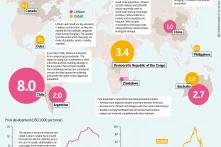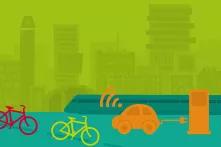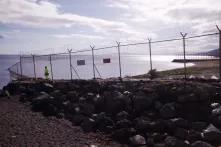There are great hopes pinned to the Moroccan energy transition – not just in the North African kingdom itself, but also in Europe and Germany.

In the future, Morocco plans to supply large quantities of solar energy and green hydrogen to Europe and thus pave the way for climate neutrality, according to calculations in Madrid, Paris and Berlin.
Morocco is unquestionably a forerunner of climate and energy policy in Africa, and the rest of the world as well. The Maghreb state is pursuing ambitious CO2 reduction objectives and has been an active participant in international climate talks – in 2016, Morocco hosted COP22 in Marrakesh. By the end of 2020, the country had achieved an installed capacity of just over 40% renewables, a figure that is expected to grow to 52% by 2030. The figurehead of this success story is the Noor solar thermal power plant in Ouarzazate, the world’s largest solar complex. Morocco takes one of the top places in the Climate Change Performance Index 2021, compiled by Germanwatch.
Morocco has now added another ambitious objective through its energy policy agenda: it hopes to become the world market leader in the production of green hydrogen. Soaring demand for the new zero-emissions fuel means that hydrogen production is a sure-fire future sector. Morocco has no intention of letting this lucrative opportunity slip through its fingers. Alongside the technical and financial feasibility of these highly ambitious plans, however, there is also the small question of how this focus on export will impact upon the Moroccan energy transition and the people of the country.
Prospects for hydrogen production: there is still a shortage of clean energy and water
What makes this North African country so attractive as a potential supplier of hydrogen? The answer lies chiefly in its potential to generate large quantities of solar energy, which is required for the production of green hydrogen (see info box). This is why Germany and Europe have invested so much hope in the Moroccan energy transition. The country boasts extremely favourable climatic conditions, has already invested massively in renewable energies and is right on Europe’s doorstep.
Morocco plans to make the most of this and to produce green hydrogen from solar electricity for export in the future. So far, this ambition has been strongly driven by demand and has been brought to Morocco from outside – specifically by Germany and other EU member states keen to secure their access to the “oil of the future”. This is reflected for instance in the Germany-Morocco Hydrogen Agreement, which was signed in Berlin in June 2020 (article available in German only) and provides for the Federal Republic to support Morocco in constructing a hydrogen production plant and with the subsequent production of green hydrogen. Resources to the tune of €300 million have already been pledged for this – an investment that will allow Germany to source green hydrogen from Morocco in the future.
But there is still a long way to go until Morocco is in a position to export green hydrogen. For one thing, it must first produce far more electricity from renewable sources than is currently the case. In 2019, just 4% of all electricity produced came from solar panels (1,581 GWh), 12% from wind power (4,587 GWh) and 4% from hydropower (1,654 GWh) (article available in French only). By way of comparison, a total of 47,500 GWh of solar power were produced in Germany in 2019 (article available in German only) – more than was generated in Morocco that year from conventional and renewable energy sources put together.
For another thing, the Kingdom of Morocco lacks the water that is needed for hydrogen production. Many regions of the country are already struggling with water shortages. The scarce freshwater resources are the subject of local conflicts and place strict limits on small-scale agriculture. For this reason, Morocco is looking to extract the freshwater required from desalination plants. But these will also have to be powered by green electricity in order for the hydrogen produced to be genuinely climate-neutral. In other words, more solar power will be required.
Morocco’s energy transition – many huge power plants, very few actors
To understand where the necessary green electricity for hydrogen production is supposed to come from, a broader overview of the Moroccan energy transition is required. Unlike the situation in Germany, where the energy transition has chiefly developed in a decentralised fashion, with many actors producing their own electricity to feed into the grid, the expansion of renewables in Morocco is very much centralised and managed by the state. The central actors are just two agencies, one publicly owned and the other semi-public, which are permitted to build and operate wind and solar energy plants. The first of these is the National Office of Electricity and Drinking Water (ONEE – Office national de l'électricité et de l'eau potable), which also operates the Moroccan national power grid. The second is the Moroccan Agency for Sustainable Energy (MASEN), which has links to the royal family of the country and was created in 2010 for the purposes of developing, expanding and operating solar and wind power plants. This means that regenerative energy produced in Morocco comes mainly from large solar power plants and wind farms that were primarily funded by international development banks. The German development bank KfW, for instance, channelled €830 million into the construction of the Noor solar power plant, corresponding to just over a third of the total investment amount. Moroccan civil society organisations have spoken out against the state’s fixation on mega power plants, because large solar plants such as Noor are planned with no say for the local population and create very few jobs locally, whilst taking enormous areas of land out of use for local residents.
For private companies, on the other hand, there has so far been practically no chance of entering the lucrative solar and wind energy market. This is chiefly because businesses, communities and private households producing electricity for their own needs are not allowed to feed any surplus into the grid. Efforts have been in train for years for a medium-term opening up of the electricity market and grid to new actors, but there is still no legal basis for this. While the government clearly lacks the political will required for such a reform, the downstream energy authorities and agencies have no very great interest in liberalising the renewables market. ONEE, in particular, has a large portfolio of fossil-fuel power stations and therefore every interest in amortising its investments in new facilities, such as the coal-fired power station opened in 2018 in Safi. The result of this is that coal power’s share in the Moroccan energy mix has grown by 70% since 2014[1] and new power plants, like the one in Safi, are working at full capacity. At the same time, the potential of renewables is not being fully exploited – only 20% of the electricity produced in 2019 came from renewable sources (article available in French only), even though up to 40% would have been technically possible. Consequently, Morocco is still working below capacity in the generation of renewables and decarbonisation of energy production.
Energy for export – but not at the expense of the Moroccan population
The promise of green hydrogen and, in particular, the economic prospects of exporting it will probably lead to a new renewables boom in Morocco, because this is what is currently still in short supply, alongside the technical facilities and expertise in the production of hydrogen: large amounts of green electricity. It remains to be seen how the anticipated boom will affect the Moroccan energy transition.
In the best-case scenario, in the hopes of many experts, the immense demand for renewable energy will lead to a rapid liberalisation of the Moroccan electricity market (article available in French only), because the current centralised virtual monopoly model will not be capable of producing the required amounts of clean electricity under competition conditions. Hydrogen could therefore end up opening the door to private enterprise, communities and households and create a more diverse electricity market in Morocco.
Or it could go the other way entirely. Other experts fear that the existing structure of large solar power stations operated by a handful of (semi-) public actors could be further cemented by the new export focus of electricity and hydrogen production. This is because it is likely that the future expansion of renewables will also be supported and fed into primarily by international donor funds. In such quantities, these resources could realistically only be absorbed by the state and invested in large facilities.
In either scenario, however, the next question is who will be given priority in the subsequent use of the green electricity and hydrogen produced. Morocco is already exporting small amounts of electricity to Spain by undersea cable. To avoid competition distortions for Spanish businesses bound by the rules of the European emissions trading system, Madrid is currently campaigning for an EU CO2 tax on imported coal-based electricity (article available in French only). The inevitable consequence of this is that Morocco will export only electricity generated from solar and wind, using more coal electricity for its domestic needs.
But the focus on export must not come at the expense of the local population, or the energy transition could lose all legitimacy in the eyes of the citizens. Morocco should therefore make sure that its own population is able to benefit from the hydrogen boom and that the share of renewables in the domestic electricity mix is progressively increased – even if it means that Germany and Europe might have to wait a bit longer for their green hydrogen.
This article was first published in German on boell.de.
[1] Amegroud, Tayeb (2020): « Devenir du secteur de l’électricité au Maroc. Contribution de l’association Energies au débat sur le nouveau modèle de développement », p. 29.


